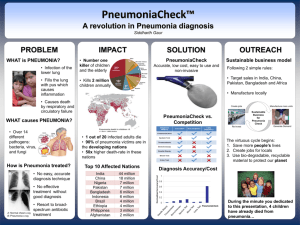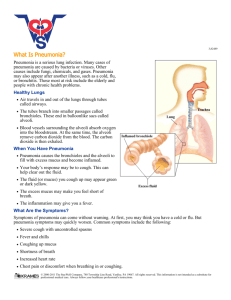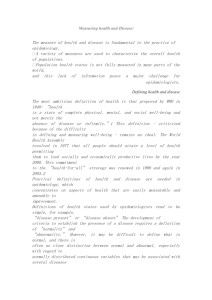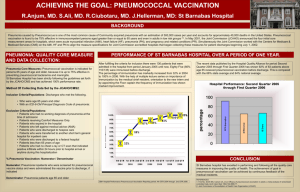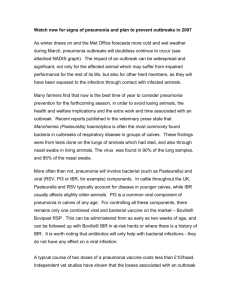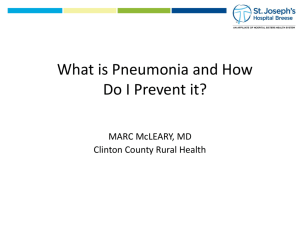Kandalyn Fogg Research Paper
advertisement
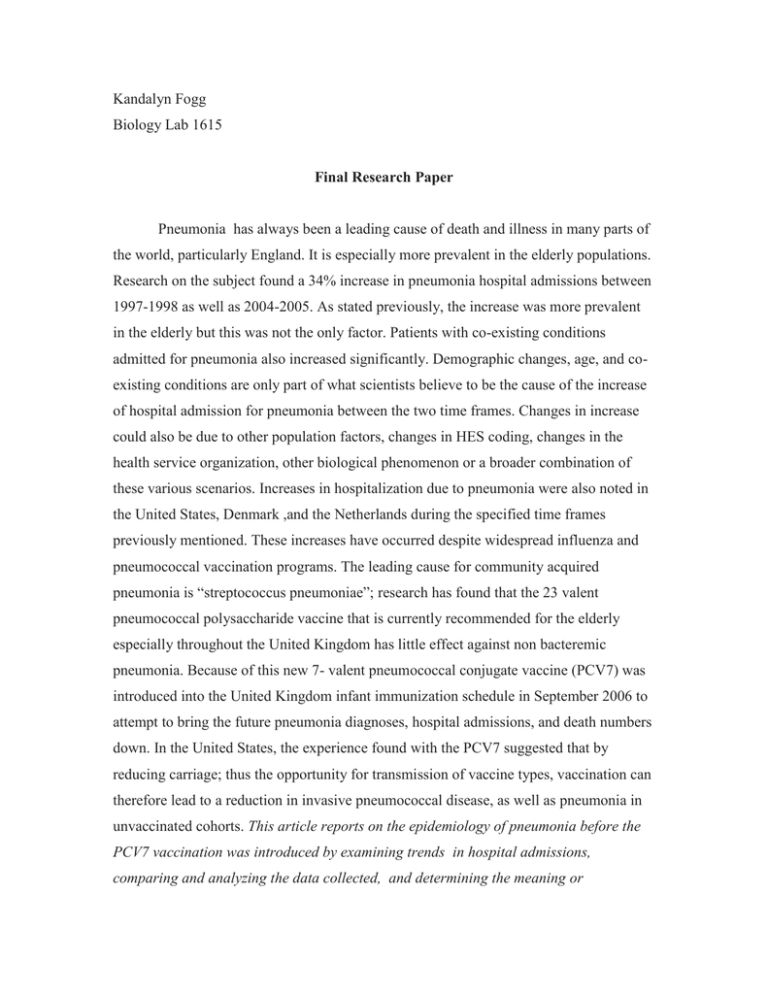
Kandalyn Fogg Biology Lab 1615 Final Research Paper Pneumonia has always been a leading cause of death and illness in many parts of the world, particularly England. It is especially more prevalent in the elderly populations. Research on the subject found a 34% increase in pneumonia hospital admissions between 1997-1998 as well as 2004-2005. As stated previously, the increase was more prevalent in the elderly but this was not the only factor. Patients with co-existing conditions admitted for pneumonia also increased significantly. Demographic changes, age, and coexisting conditions are only part of what scientists believe to be the cause of the increase of hospital admission for pneumonia between the two time frames. Changes in increase could also be due to other population factors, changes in HES coding, changes in the health service organization, other biological phenomenon or a broader combination of these various scenarios. Increases in hospitalization due to pneumonia were also noted in the United States, Denmark ,and the Netherlands during the specified time frames previously mentioned. These increases have occurred despite widespread influenza and pneumococcal vaccination programs. The leading cause for community acquired pneumonia is “streptococcus pneumoniae”; research has found that the 23 valent pneumococcal polysaccharide vaccine that is currently recommended for the elderly especially throughout the United Kingdom has little effect against non bacteremic pneumonia. Because of this new 7- valent pneumococcal conjugate vaccine (PCV7) was introduced into the United Kingdom infant immunization schedule in September 2006 to attempt to bring the future pneumonia diagnoses, hospital admissions, and death numbers down. In the United States, the experience found with the PCV7 suggested that by reducing carriage; thus the opportunity for transmission of vaccine types, vaccination can therefore lead to a reduction in invasive pneumococcal disease, as well as pneumonia in unvaccinated cohorts. This article reports on the epidemiology of pneumonia before the PCV7 vaccination was introduced by examining trends in hospital admissions, comparing and analyzing the data collected, and determining the meaning or significance of their ending conclusions from their admission case studies occurring in England during an eight year period. (1997-2005) Research on the increasing hospital admissions due to pneumonia began in order to better understand the relationships between age, co-existing conditions, demographic change, other population factors, changes in HES coding, changes in the health service organization, or other biological phenomenon. Based on the data collected after implementing the PCV7 vaccine, the overall number of diagnoses, admissions, and deaths due to pneumonia went down. This result leads scientists to question what the initial cause (or causes) for the initial increase of the disease in previous years. Scientists predicted that certain individuals or groups of the population (such as the elderly or those with pre- existing conditions) played a part, but they also believed that there was more to it. The research conducted to write this article centered around the numbers and types of hospital admissions due to pneumonia. Though upon further study, individuals that were discovered to have developed pneumonia after admission- were also included in the study. Information on these admissions/cases were gathered from the HES (hospital episode statistics) which came form the NHS (national health service) information center for health and social care; these sources contain details of all admissions to the NHS hospitals in England. Through the HES data base, scientists and researchers were able to get important details and information about the length of time of the admission stay, as well as how many pneumonia episodes were recorded during the patients stay. A patient identifier was created based on the patient’s birth date, postal code, and sex to maintain anonymity. Other information such as cases of pneumonia that directly resulted in death were also recorded; co-existing conditions were also grouped into 4 levels: non coexisting conditions, mild, moderate, or severe co-existing conditions. Statistics were gathered to compare the effects of alcohol consumption among patients, as well as the seasonal effects. It was believed that many if not all of these aspects correlated directly to the rising cases of pneumonia. Scientists came up with various results in conclusion to their research. In cases where the primary diagnoses was pneumonia, researchers found an approximate increase of 72,060 between 1997-1998 and 2004-2005. An overall age standardized incidence rate of 34% was also noted among the primary diagnoses studies. Patients that developed pneumonia after their primary diagnosis increased in number from 110,143 to 153,312; the same age standardized incidence rate also increased among the patient population. (meaning the elderly were more susceptible) Co-existing conditions found in patients varied over time and age. In all age groups, the proportion of patients with co-existing conditions increased. In addition, each year 1% of the overall patients had an additional alcohol related code recorded. These codes were slightly more common in those over the age of 65. The length of stay was also studied, and averaged out to 3 days, increasing with the patient’s age. Admission patterns were also analyzed, and researchers found that admissions occurred more often over the weekend. Incidence of admission was also noted more often during the winter months. Mortality rates were significantly higher in older adults. The odds of death were also much higher between 1997-1998 than in 20042005. All the information gathered by researchers and scientists supports the theory that prior to the PCV7 vaccination, multiple factors contributed to the previous rise of pneumonia cases throughout the United Kingdom. It is important to understand that there are often multiple causes for a peak or significant prevalence in certain populations of illnesses like pneumonia. Without this additional knowledge, further interventions would be impossible. For instance, in this article, multiple contributing factors were found to influence the rise of pneumonia. This information is crucial to prevent future excessive outbreaks, ensuring the success of the PCV7 vaccination. Understanding the past helps us to ensure a better future.
